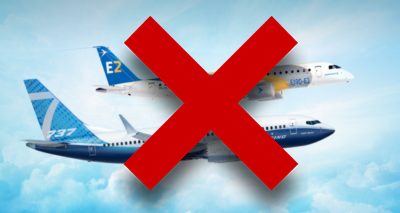
As Boeing scrambles to conserve cash in the wake of the COVID-19 pandemic, the $4.2 billion merger with Embraer has become a casualty. The company announced that it was terminating the Master Transaction Agreement (MTA), stating that “Boeing exercised its rights to terminate after Embraer did not satisfy the necessary conditions.”
Both the commercial joint venture, Boeing Brasil – Commercial (BBC), and the military venture, Boeing Embraer – Defense, were canceled as a result of this decision.
A Reuters report indicated that the deal collapsed when Boeing refused to extend a deadline on April 25.
Embraer immediately responded, saying in a statement that Boeing “has manufactured false claims as a pretext to seek to avoid its commitments to close the transaction and pay Embraer the US$4.2 billion purchase price. We believe Boeing has engaged in a systematic pattern of delay and repeated violations of the MTA, because of its unwillingness to complete the transaction in light of its own financial condition and 737 MAX and other business and reputational problems.”
With the deal dead, Embraer may look to China as a possible partner in the operation. While an earlier venture in China has been phased out, this may present a fresh opportunity for the two to renew discussions.
The previous joint venture effort between the two, Harbin Embraer Aircraft Industry Company Ltd, was phased out in 2016. The venture was originally formed in December 2002 to manufacture 50-seat ERJ 145 jets in China. These aircraft were marketed primarily in the People’s Republic of China (PRC), where the market had slowed at the time. The company had wanted to produce the E-190 regional jet in China after local production of the ERJ 145 ceased, but failed to obtain approval from Chinese authorities. In addition, Embraer was embroiled in tax disputes over the venture that likely impacted the decision to close the operation. Embraer owned 51 percent of this company.
Boeing/Embraer Merger Timeline
In July 2018, Boeing and Embraer signed a Memorandum of Understanding ( MoU) to establish a new commercial aircraft entity, majority-owned by Boeing. Under the terms of the agreement, Boeing was to pay $4.2 billion for an 80 percent stake in the joint venture, up from $3.8 billion when originally proposed, valuing it at $5.25 billion – up from $4.75 billion when it was originally proposed. Embraer was to own the remaining 20 percent.
On finalization, the commercial aviation joint venture would have been led by Brazil-based management, including a president and chief executive officer. Boeing would have had operational and management control of the new company, which would have reported directly to Boeing’s CEO. In May 2019, Boeing announced the venture was to be called Boeing Brasil – Commercial (BBC). No decision had been made as to whether the aircraft would be rebranded as Boeing models.
In addition, the companies agreed to the terms of another joint venture to promote and develop new markets for the rebranded C-390 Millennium airlifter and the KC-390 aerial refueling variant. In November 2019, Boeing and Embraer announced this joint venture would be called Boeing Embraer – Defense. Under the terms of this partnership, Embraer was to own a 51 percent stake in the venture, with Boeing owning the remaining 49 percent.
Embraer planned to hold on to its Executive Aviation unit, which produces the Legacy and Praetor business jets. In June 2019, Embraer announced it would be shifting business jet production from Sao Jose dos Campos to Gaviao Peixoto as it readied for the merger with Boeing. Since Boeing Brasil – Commercial was expected to assume regional jet production in Sao Jose dos Campos, Embraer began shifting Legacy 450/500 and Praetor 500/600 business jet manufacturing to its facility in Gaviao Peixoto. The business jets will be manufactured at this location, then sent to Melbourne, Florida, for finishing.
In January 2020, the venture won final approval in Brazil. The European Commission was in the midst of assessing the deal. The slow process in the European Union is reported to be due to administrative matters, such as documentation requests, and not to any issues related to competition.
Talks on the possible tie-up began in December 2017. Driving this deal was Airbus’ takeover of Bombardier’s CSeries commercial jetliner program, now known as the Airbus A220. A teaming between Boeing and Embraer would have allowed the two firms to better compete against the A220, which has been the focus of several trade disputes in both Brazil and the U.S.
C-390 Marketing Agreement Intact for Now
In July 2016, Embraer and Boeing signed a teaming agreement to jointly market and support the KC-390. Under the agreement, the companies will pursue new business opportunities, both for the aircraft itself and for aircraft support and sustainment. Embraer will provide the aircraft, and Boeing will be responsible for in-service support.
The agreement expands an existing collaboration between the two companies. In 2012, they first announced their intention to jointly market the aircraft. Under this agreement, Boeing is the lead for KC-390 sales, sustainment, and training opportunities in the U.S., the U.K., and select Middle East markets. Embraer would manufacture the aircraft and collaborate on sales, sustainment, and training.
Despite the failed merger, according to Boeing the two companies will maintain their existing Master Teaming Agreement, originally signed in 2012 and expanded in 2016, to jointly market and support the C-390 Millennium military aircraft.
The KC-390 collaboration is part of a broader agreement that Boeing and Embraer signed in April 2012. The companies previously announced that they were exploring ways to cooperate in the areas of commercial airplane efficiency and safety, research and technology, and sustainable aviation biofuels.
Embraer is a long-time subcontractor to Boeing. Specifically, Embraer supplies machined flap supports for both the 747 and 767 programs. In addition, Embraer received a contract to produce wingtips and dorsal fin fairings for the 777.
A military history enthusiast, Richard began at Forecast International as editor of the World Weapons Weekly newsletter. As the Internet grew in importance as a research tool, he helped design the company's Forecast Intelligence Center and currently coordinates the EMarket Alert newsletters for clients. Richard also manages social media efforts, including two new blogs: Defense & Security Monitor, covering defense systems and international issues, and Flight Plan, which focuses on commercial aviation and space systems. For over 30 years, Richard has authored the Defense & Aerospace Companies, Volume I (North America) and Volume II (International) services. The two books provide detailed data on major aerospace and defense contractors. He also edits the International Contractors service, a database that tracks all the contractors involved in the programs covered in the FI library. More recently he was appointed Manager, Information Services Group (ISG), a new unit that encompasses developing outbound content for both Forecast International and Military Periscope.




